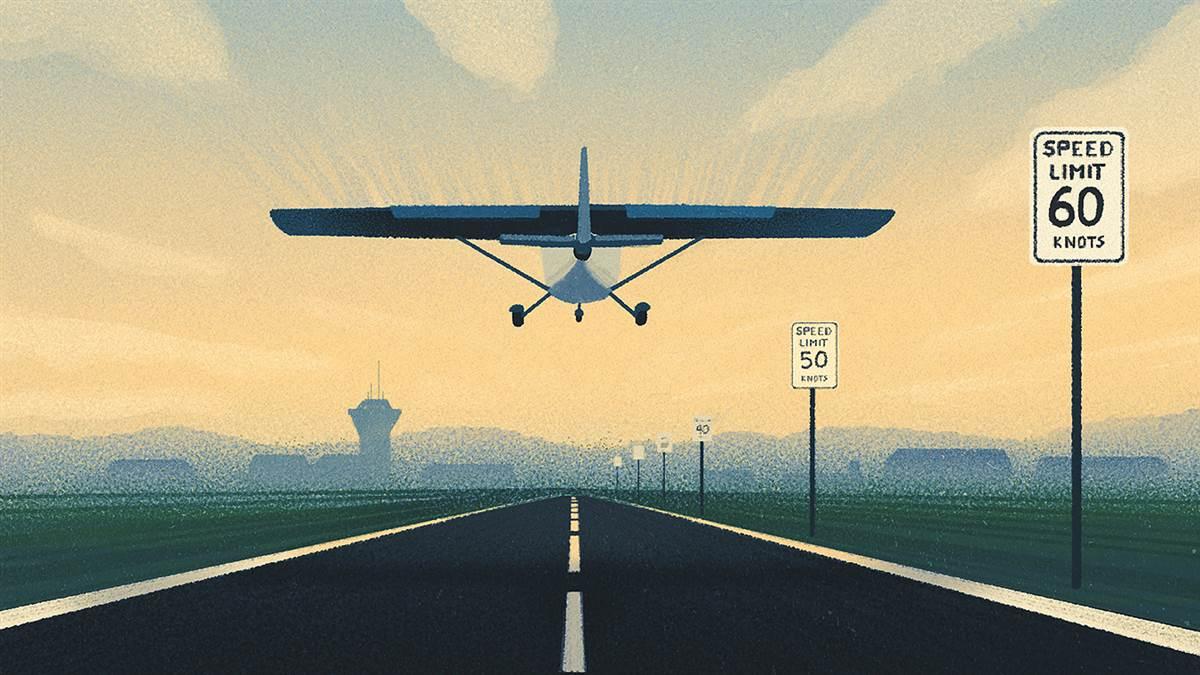Importance of airspeed
Fundamentals are critical, no matter the skill level
By John W. Olcott
Alliteration, the purposeful use of a repetitious sound in nearby words or phrases, is a memory aid in aviation training.

For example: Pitch for airspeed, power for altitude. Attitude determines airspeed. And so it goes.
Another important mantra that uses alliteration is airspeed awareness assures safety.
Airspeed plays a vital role in all aspects of safe flight. From a big-picture perspective, if airspeed is too slow the aircraft stalls; if airspeed is too fast the aircraft’s structure fails. Airspeed, however, has additional and more subtle influences on how an aircraft behaves. Airspeed affects control sensitivity: The slower the airspeed, the less effective the controls. It affects performance: Specific airspeeds presented in the aircraft’s pilot’s operating handbook must be established to have optimum takeoff, climb, cruise, and landing performance for an aircraft’s weight, configuration, and atmospheric condition. Precise control of airspeed is a requirement for achieving POH performance. For example, adding knots on approach gives a greater margin above stall at the risk of floating during the landing flare, which significantly compromises safety if runway length is critical.
Awareness of airspeed, including its present value and whether airspeed is increasing or decreasing, is essential for safe flight. When airspeed is faster than stall and slower than never exceed speed, pilots can maneuver safely without losing control. Obviously, when an aircraft experiences catastrophic structural failure the pilot loses control completely.
Lest we forget, loss of control in flight tops the NTSB’s list of fatal accident causes. Proper control of airspeed prevents loss of control. Distraction is often cited in loss of control accidents, where the aircraft stalls because of the pilot’s inattentiveness to the aircraft’s airspeed.
Airspeed awareness must be an integral part of a student’s training program. Knowledge of what airspeeds to fly and skill to fly those airspeeds precisely must be part of each lesson. Thinking of the airspeed indicator as a “safety indicator” increases a student’s awareness of and appreciation for airspeed.
No degree of pilot experience or credentials negates the importance of airspeed and angle of attack. Nor does the sophistication of an aircraft’s instrumentation and flight control system. Compliance with standard operating procedures given in the aircraft’s flight manual or POH always apply, and when SOPs are not followed because of equipment failure, distractions, or pilot confusion, problems arise.
Consider the tragic loss of Air France 447, an Airbus 330 on a night flight from Rio de Janeiro to Paris June 1, 2009. Although the A330 was certified for a crew of two, a captain with more than 11,000 flight hours and two experienced first officers were assigned to the trip by regulation because the flight’s planned duration exceeded 10 hours. Following Air France SOP, the captain was second to take his rest about three hours after departure and left the flight deck for the aircraft’s designated rest area. Shortly thereafter the A330 encountered an area of thunderstorms with turbulence and icing conditions. Airspeed indication was compromised because ice was blocking the redundant pitot systems, and the autothrottle and autopilot disengaged.
Manipulating the aircraft by hand, the pilot flying apparently had difficulty adapting to the situation. His control inputs resulted in attitude excursions that stalled the aircraft as the A330 pitched upward from its assigned altitude of 35,000 feet to approximately 38,000 feet. Re-entering the flight deck, Flight 447’s captain found the two first officers struggling to understand what was happening. Neither co-pilot at the controls nor the captain overseeing the situation discerned that the aircraft was fully stalled as it mushed downward from 38,000 feet, a descent that lasted three minutes and 30 seconds. The aircraft pancaked into the ocean belly-first in a wings-level attitude, and all occupants were lost.
Air France Flight 447’s crew with more than 20,000 hours of collective flight time failed to realize the aircraft had stalled. Although the A330’s instrumentation continued to provide flight information, investigators suggested several factors might explain the crew’s lack of stall awareness, even though the A330 stall-warning system sounded more than 70 times and its pitch attitude ranged between 35 and 45 degrees. The crew might have confused the primary flight display’s indications in the conditions they encountered, or they were unable to reason effectively because of the stress they were experiencing. For example, the crew failed to initiate procedures for dealing with unreliable airspeed indications. In particular, the accident report stated the pilots received “very little [exposure] to stall situations” during their training.
Bottom line: The aircraft was capable of safe flight, but its crew did not correct for its stalled flight condition.
AF447 is a sobering reminder of why airspeed is important. It also emphasizes the law of primacy—that which is first learned is easiest to recall. Primacy also has a corollary—that which is first learned is more likely to be recalled at moments of stress. The takeaway for students as well as flight instructors is clear: Learning the importance of airspeed, knowing what control inputs are the most effective in changing airspeed, realizing that stalls occur whenever the wing’s critical angle of attack is exceeded, and reducing angle of attack promptly when a stall is encountered are basics necessary for safe flight. Those fundamentals must be ingrained in all student pilots and reviewed routinely by all aviators.
Airspeed awareness and precise control produce safety and success.
Hear the alliteration. Remember the advice.
John W. Olcott is an airline transport pilot, CFII, and remote pilot, as well as former president of the National Business Aviation Association.


